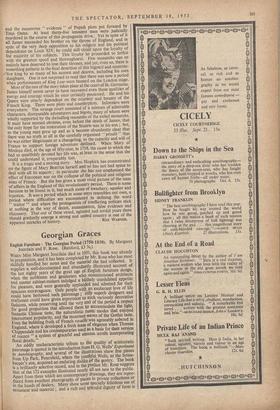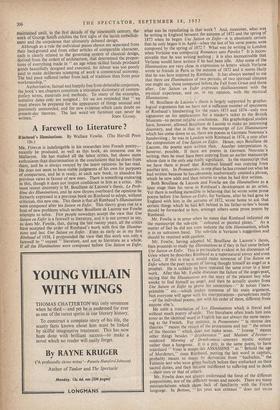Georgian Graces
English Furniture : The Georgian Period (1750-1830). By Margaret
Jourdain and F. Rose. (Batsford, 3s,)
WHEN Miss Margaret Jourdain died in 1951, this book was already in preparation, and it has been completed by Mr. Rose who has most skilfully handled her notes and the material she had collected. It supplies ,a well-documented and abundantly illustrated account of the last eighty years of the great age of English furniture design, when the noblemen and gentlemen who commissioned architects and master cabinet-makers indulged a blithely uninhibited appetite for pleasure, and were generally applauded and admired for their spacious extravagance. Only people with an exuberant love of life could have bestowed such patronage ; only superb designers and craftsmen could have given expression to such variously decorative fashions, while preserving until the very end of the period a respect for good proportion that allowed them to accommodate the light, fantastic Chinese taste, the naturalistic rustic modes that enjoyed intermittent popularity, and the recurrent waves of the Gothic taste. Even the bubbling froth of French rocaille was agreeably sobered in England, where it developed a fresh lease of elegance when Thomas Chippendale and his contemporaries used as a basis for their version of rococo " a system of graceful and sinuous scrolls incorporating floral details."
An oddly uncharacteristic tribute to the quality of aristocratic patronage is quoted in the introduction from H. G. Wells' Experiment in Autobiography, and several of the illustrations show fine pieces from Up Park, Petersfield, where the youthful Wells, as the house- keeper's son, acquired an enduring dislike of the gentry. The book is a brilliantly selective record, and in the preface Mr. Rose suggests that of the 172 examples illustrated nearly all are new to the public. Apart from three which are contemporary drawings, they are repro- duced from excellent photographs of pieces in private collections or in the hands of dealers. Many show some specially felicitous use of ornament and material ; and a rich and splendid dignity of form is maintained until, in the first decade of the nineteenth century, the work of George Smith exhibits the first signs of the lavish embellish- ment and the corpulence that ultimately debased design. Although as a rule the individual pieces shown are separated from their background and from other articles of comparable character, each is clearly related to the governing system of classical design, derived from the orders of architecture, that determined the propor- tions of everything made in " an age when skilled hands .produced goods beautifully designed and executed, for labour was too poorly paid to make deliberate scamping of work a commercial economy. The bad piece suffered rather from lack of tradition than from poor workmanship." Authoritative, factual and happily free from debatable conjecture, thebook's ten chapters constitute a miniature dictionary of contem- porary terms, materials and methods. To many of the examples, tentative dates only are assigned ; for we are reminded that " we must always be prepared for the appearance of things unusual and previously unrecorded, and for new evidence which casts doubt on present-day theories. The last word on furniture can never be



































 Previous page
Previous page